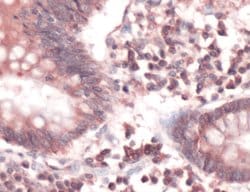Learn More
Invitrogen™ FAS Polyclonal Antibody
Rabbit Polyclonal Antibody
$566.00 - $867.50
Specifications
| Antigen | FAS |
|---|---|
| Content And Storage | Store at 4°C short term. For long term storage, store at -20°C, avoiding freeze/thaw cycles. |
| Applications | Immunohistochemistry (Paraffin) |
| Classification | Polyclonal |
| Conjugate | Unconjugated |
| Catalog Number | Mfr. No. | Quantity | Price | Quantity & Availability | |||||
|---|---|---|---|---|---|---|---|---|---|
| Catalog Number | Mfr. No. | Quantity | Price | Quantity & Availability | |||||
|
01-673-242
|
Invitrogen™
PA137368 |
1 mL |
Each for $867.50
|
|
|||||
|
PIPA532336
|
Invitrogen™
PA532336 |
500 μL |
Each for $566.00
|
|
|||||
Description
Heat-mediated antigen retrieval is recommended prior to staining, using a 10mM citrate buffer, pH 6.0, for 10 minutes followed by cooling at room temperature for 20 min. Following antigen retrieval, incubate samples with primary antibody for 10 min at room temperature. A suggested positive control is small intestine or colon tissue.
CD95, also known as Fas or APO-1, is a 46 kDa transmembrane glycoprotein that functions as a cell death receptor in the tumor necrosis factor receptor (TNFR) superfamily. It is expressed by a wide range of hematopoietic and non-hematopoietic cells, including monocytes, neutrophils, lymphocytes, and fibroblasts. CD95 also exists in a soluble form weighing approximately 26 kDa. The interaction of CD95 with its ligand, FasL, induces apoptosis, playing a crucial role in peripheral tolerance and anti-viral immune responses. Upon stimulation, CD95 leads to the aggregation of its intracellular Fas-associated death domains (FADD), formation of the death-inducing signaling complex (DISC), and activation of caspases. This cascade results in apoptosis. CD95 is also involved in activating NF-kappaB, MAPK3/ERK1, and MAPK8/JNK, and transduces proliferative signals in normal diploid fibroblasts and T cells. There are at least eight alternatively spliced transcript variants encoding seven distinct isoforms of CD95. Isoforms lacking the transmembrane domain may negatively regulate apoptosis mediated by the full-length isoform. The Fas/Fas ligand system is implicated in several human diseases, including AIDS, hepatitis, and cancer, highlighting its importance in immune regulation and disease pathology.Specifications
| FAS | |
| Immunohistochemistry (Paraffin) | |
| Unconjugated | |
| Rabbit | |
| RUO | |
| PBS with 1% BSA and 0.1% sodium azide; pH 7.6 | |
| P25445 | |
| 355 | |
| Synthetic peptide derived from C-terminus of human FAS protein. | |
| Antibody |
| Store at 4°C short term. For long term storage, store at -20°C, avoiding freeze/thaw cycles. | |
| Polyclonal | |
| Liquid | |
| IgG | |
| Human | |
| FAS | |
| AI196731; ALPS1A; APO1; APO-1; Apo1 antigen; Apo-1 antigen; APO-1 cell surface antigen; Apo-1 Fas; apoptosis antigen 1; apoptosis signaling receptor FAS; apoptosis-mediating surface antigen FAS; APT1; CD95; CD95 antigen; FAS; Fas (TNF receptor superfamily member 6); Fas (TNF receptor superfamily member); Fas (TNF receptor superfamily, member 6); Fas AMA; Fas antigen; Fas antigen (ATP1); Fas cell surface death receptor; Fas receptor; FAS1; FASLG receptor; FASTM; lpr; lymphoproliferation; OTTHUMP00000020045; OTTHUMP00000020046; OTTHUMP00000020051; OTTHUMP00000059646; TNF receptor superfamily member 6; TNFR6; Tnfrsf6; tumor necrosis factor receptor superfamily member 6; tumor necrosis factor receptor superfamily member 6; tumor necrosis factor receptor superfamily member 26; Tumor necrosis factor receptor superfamily, member 6 | |
| FAS | |
| Primary | |
| Antigen affinity chromatography |
Your input is important to us. Please complete this form to provide feedback related to the content on this product.
